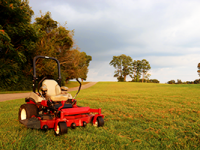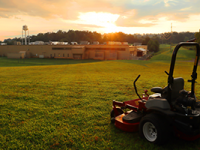Integrated ISOBUS Functions Help Agriculture Sector Plow Ahead
 As the case is across many sectors, electronics systems are the primary drivers of innovation in today‘s agricultural industry. However, those working in this sector may have noticed that any major strides forward in past years have been somewhat hampered by a lack of compatibility between proprietary solutions from different manufacturers.
As the case is across many sectors, electronics systems are the primary drivers of innovation in today‘s agricultural industry. However, those working in this sector may have noticed that any major strides forward in past years have been somewhat hampered by a lack of compatibility between proprietary solutions from different manufacturers.
Fortunately, more recent solutions have been based on ISOBUS, bringing significant benefits to end applications and their users. And now, with the latest technology, combining HMI solutions for both ISOBUS functions and other tractor HMIs are leading to the possibility of just one, convenient, cost-effective and efficient interface for the operator.
Modern ISOBUS systems
A modern ISOBUS system comprises a multitude of components, including the tractor, terminal and implement. Taking this concept a step further, an industry first from Parker’s perspective, the ISOBUS Suite Apps enable the integration of ISOBUS functionalities into the machine HMI (Human Machine Interface), via the app-based Pro Display product family.
Using the apps, ISOBUS functions can be shown on the screen. Since the display offers full flexibility and can show comprehensive information – including machine data, notifications, camera monitors, PDFs and more – no separate ISOBUS display is required.
Changing the landscape
Farmers have been forced to toil with tractors, implements and machines from various manufacturers on a daily basis. The variety of proprietary solutions meant that many systems did not engage seamlessly or even at all. This disunity saw each implement and tractor requiring an individual terminal to allow data exchange and machine control – a situation that was far from ideal.
Systems based on ISOBUS and utilising tools such as Parker’s ISOBUS Suite apps are driving a shift in the agricultural landscape, making it possible to achieve higher levels of productivity with less operator fatigue.
Using these latest electronic systems, operators can now control and monitor practically every stage of the agricultural process, including tilling the soil, planting seeds, irrigating the land, cultivating crops, protecting them from pests and weeds, harvesting, threshing grain, feeding livestock, and sorting and packaging the products.
How it works
In its basic form, the technology facilitating this capability is ISOBUS, an international communications protocol for the agricultural sector that offers plug-and-play functionality and – importantly – only one terminal for a large selection of implements, regardless of the manufacturer. Sounds a lot easier already. Put simply, ISOBUS standardises control settings, reduces downtime and minimises installation and interface problems.
Crucially here, a standardised plug makes it remarkably easy to connect different components, while costs are reduced because it is only necessary to buy a single terminal. Who doesn’t like cost savings? A further benefit of ISOBUS is that it improves operating efficiency and optimises timings, as data can be exchanged between the farm PC and the terminal. With ISOBUS, life on the farm is certainly a whole lot easier; but it could even better.
 By utilising Parker’s UX Toolkit – an apps-based software development environment that can be used to develop HMI products for mobile machines and vehicles – and the split-screen functionality, manufacturers can display further machine data and camera monitors right next to the ISOBUS information.
By utilising Parker’s UX Toolkit – an apps-based software development environment that can be used to develop HMI products for mobile machines and vehicles – and the split-screen functionality, manufacturers can display further machine data and camera monitors right next to the ISOBUS information.
Machine manufacturers can expand the functionality of a device with ease. HMI apps offer an advantage when trying to make mobile machines more efficient, when guaranteeing flexibility in terms of expanding functionalities, and when simplifying processes in the driver’s cab. Less downtime is achieved via diagnostics apps for service code protocols, data capturing and analysis, GPS tracking and geo-fencing, as well as by apps that enable mobile phone hands-free functionality, driver logbooks and operating behaviour tracking.
The UX Toolkit, together with the Pro Display family, also supports functions such as automatic steering, self-levelling suspension and weighing. In addition, the robust displays with capacitive touchscreens are equipped with multiple communications and infotainment interfaces. In short, an apps-based future looks set to enhance the agriculture industry in ways never before imagined.
Learn more about Parker’s ISOBUS Suite apps and Pro Display.

Article contributed by Tommi Forsman, principal engineer, Parker Hannifin, Mobile Systems Division Europe (MSDE) – Electronic Controls Business Unit. (ECBU)
Related content:
Modern Digital Ecosystems Take Mobile Hydraulic Systems to a New Level
How Does a Smart User Interface Improve Machine Efficiency?
Source: Parker Feed





